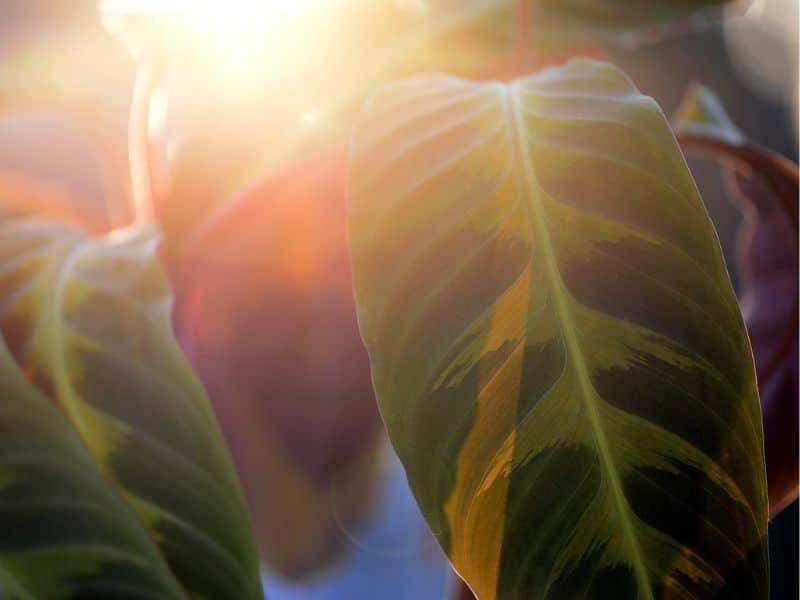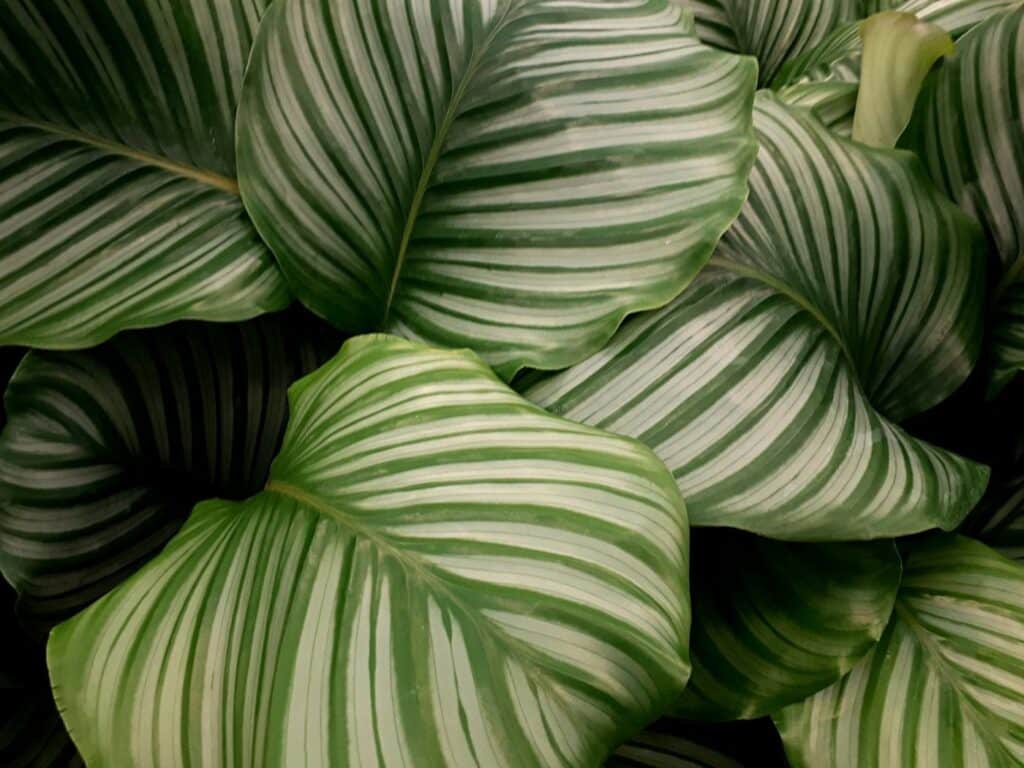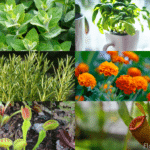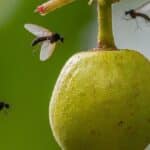You’ve nurtured your Calathea with utmost care, but those yellow leaves cropping up are starting to worry you. You’re not alone in this struggle. Many plant enthusiasts often encounter this issue, turning their green thumb into a source of stress.
But don’t fret – we’re here to help you understand and address the root cause of this common problem.
In the world of indoor plants, Calatheas are known for their stunning foliage. However, they can be a bit finicky, especially when it comes to their leaf color. A sudden change to yellow can be a sign of several issues that we’re about to delve into. So, sit back, relax, and let’s unravel this leafy mystery together.
Understanding Calathea Yellow Leaves
Calathea plants are famous for their vibrant and intricately patterned leaves. However, the shift from vibrant green to yellow brings worry for many plant owners. This section delves into understanding the significance of leaf color change and common causes of yellow leaves.
The Significance of Leaf Color
Color plays a crucial role in botany and it’s more than mere aesthetics. In Calatheas, leaf color directly corresponds to health status. The usual lush green means all systems operate spectacularly. However, yellow can be a distress signal calling attention. It’s like a check engine light on your car’s dashboard. Keep an eye on any color change, as it’s always indicative of possible plant issues.
Common Causes of Yellowing Leaves
Calathea leaves turning yellow could be attributed to various underlying nuisances:
- Overwatering: It’s the leading Calathea offender. Soaked roots often result in droopy, discolored leaves. A complete drainage setup helps in thwarting waterlogs.
- Poor Water Quality: Calatheas prefer distilled or rainwater. Chemicals found in tap water may well wreak havoc on your plant causing yellowing leaves.
- Inadequate Lighting: It’s a tricky affair as these plants avoid direct sunlight yet need sufficiently bright light. Balance is key.
- Nutrient Deficiency: A diet lacking essential nutrients can usher in yellow leaves. Regular feeding with a well-balanced fertilizer offers a lifeline in such situations.
Spotting a yellow leaf doesn’t spell doom for your Calathea. Identify the problem early on and take corrective action swiftly. After all, your plant’s vibrancy relies on your attentive care.
Assessing Your Calathea’s Health

Understanding the reason behind the yellow leaves of your Calathea plant can be insightful. The health of this vibrant houseplant is tied to careful observation of its physical conditions. Specific signs may indicate issues related to overwatering or nutrient deficiency.
Signs of Overwatering
Distinguishing signs of overwatering your Calathea plant isn’t rocket science. Soggy soil indicates overwatering. One key sign is the wilting of leaves despite the soil’s damp condition.
But remember, overwatered Calathea leaves turn yellow before they wilt. Additionally, small growth or brown leaf edges signify excess watering. Continuously repeating this action results in the plant’s leaf cells bursting, leading to yellowing.
Indicators of Nutrient Deficiency
Is your Calathea plant lacking nutrients? Then take note of some clear signs. Yellowing leaves, particularly at the tip or edge, could mean it lacks necessary nutrients. Lackluster growth, stunted new leaves, or perhaps leaf vein discoloration, all hint towards a nutrient deficiency.
Consider examining the plant for these symptoms, taking swift action preserves the vibrancy of your Calathea plant. The freedom to amend the soil gives you the chance to alter its nutrient content, thereby safeguarding your plant’s future.
Best Practices for Calathea Care

In keeping your Calathea’s leaves vibrant, proper watering techniques, ideal lighting conditions and a good level of humidity are top on the list of priorities.
Proper Watering Techniques
Mindful watering practices can restore the balance your Calathea craves. Use room-temperature filtered water or rainwater, as cold tap water may shock the plant and its harsh minerals contribute to the yellowing of leaves.
Water the plant only when the top half-inch of soil is dry. It’s also vital to ensure that your Calathea’s pot has ample drainage holes, this helps avoid waterlogging the roots which can have detrimental effects on the plant’s overall health.
Ideal Lighting Conditions
Providing your Calathea with the optimal light conditions will support leaf vibrancy. Calatheas prefer filtered or indirect light as direct sunlight can scorch the leaves leading to yellow pigmentation. Placing your plant near an east or north-facing window typically offers a balance of sufficient light without the risk of sun damage.
The Importance of Humidity
All types of Calatheas thrive in high humidity. A common cause of the yellow leaf issue, dry air stresses the plant, leading to browning and eventual yellowing of leaves.
You can maintain a suitable humidity level by either grouping your plants together, placing your plant on a pebble tray filled with water, or using a humidifier. Mist your Calathea regularly and ensure it’s kept in a space with adequate air circulation, like near a window or fan.
With these strategies, the beauty and health of your Calathea’s leaves can be preserved, ensuring a vibrant appearance. Remember, Calathea care isn’t a one-size-fits-all scenario, adjustments may be required based on your plant’s individual needs.
Troubleshooting Yellow Leaves on Calathea
Adjusting Your Watering Schedule
Review your watering habits. Calatheas don’t thrive in an overly-moist environment. If your plant’s leaves turn yellow, one of the first things you may well want to examine is the frequency and volume of watering.
Think about adjusting your watering schedule according to the plant’s specific requirements. Instead of keeping to a rigid schedule, contemplate watering your Calathea based on soil dryness. Make a habit of checking the top inch of the soil before you decide to water. If it’s dry, go ahead and water; if it’s moist, give it more time.
Evaluating Light and Placement
Examine your plant’s location. Calatheas appreciate brightness, but direct sunlight can harm them. Yellow leaves may indicate a lighting problem. Modulate your plant’s exposure to sunlight, remembering that indirect light provides the optimal conditions for this breed of plant.
Observe the changes in the leaf color that follow your adjustments, it’s a great gauge of whether you’ve hit the sweet spot with lighting.
When to Use Fertilizer
Consider the role of nutrients in plant health. Yellow leaves can also be a symptom of nutrient deficiency in Calatehas. Fertilizers can provide the missing nutrients but use them wisely, excessive use can lead to leaf burn.
An astute gardener knows that a balance is key: use a water-soluble, balanced fertilizer diluted to half the recommended strength. Only apply it in the growing season, typically from spring to early autumn, as this matches the Calathea’s natural growth cycle.
Reviving Your Calathea Plant
Addressing the yellow leaves issue is key, but restoring the plant to its full glory offers a broader scope. This section delves deeper into some essential steps you can take.
Pruning Yellow Leaves
Beginning with the immediate solution, pruning the yellow leaves is crucial. By trimming the affected leaves, you remove the area of the plant consuming unnecessary resources.
This act not only benefits the overall plant health but also provides a clean, aesthetic look. Start by sanitizing your pruning shears, then proceed to prune at the leaf’s base, close to the main stalk. Mindfully take care not to damage the healthy leaves and new sprouts.
Soil and Pot Considerations
Refocusing on soil and pot elements, both significantly affect your plant’s health. A well-draining soil mimics the natural soil of Calathea plants in their natural habitat: the rainforest floor. Hence, a mix of peat, perlite, and bark often proves ideal.
Equally vital is the pot quality and size. Ensure it is sufficiently large, with ample drainage holes to avoid water retention. Ceramic or clay pots usually offer a true advantage, providing breathability ideal for Calatheas.
Monitoring and Ongoing Care
Your Calathea’s journey does not end here. Constant vigilance is the price of a lovely, healthy plant. Keep a watchful eye on your Calathea, checking for signs like wilting, discolored leaves, or stunted growth. Adjust watering or sunlight exposure promptly when necessary.
Regular fertilization, preferably bi-monthly during growing seasons, keeps your plant nourished. Above all, remember that a healthy Calathea requires time, and patience remains your most potent tool.
FAQs
Why do Calathea leaves turn yellow?
The yellowing of Calathea leaves is typically due to overwatering or nutrient deficiencies. These issues can be identified by routinely monitoring the plant’s physical conditions.
What should one do when Calathea leaves turn yellow?
As a first step, prune the affected leaves. Optimize the plant’s conditions by adjusting the watering schedule and modifying the soil mix. Ensuring the pot has adequate drainage is also crucial.
How can I prevent my Calathea plant from developing yellow leaves?
Preventing leaf yellowing involves regular monitoring and necessary care. This includes adjusting the watering intervals, using an appropriate soil mix that supports plant health, and maintaining a vigilant eye over the plant’s overall condition.
Are yellow leaves on Calathea plants a symbol of plant health deterioration?
Yes, yellow leaves can indicate a decline in plant health, mostly due to factors like overwatering and nutrient deficiency, among others.
Can yellow leaves on Calathea plants be revived?
While an already yellowed leaf cannot revert back to its green state, the overall health of the plant can be revived. This requires immediate addressing of the underlying issues following the yellowing, including adjusting watering schedules and enhancing soil conditions.
Up next:







